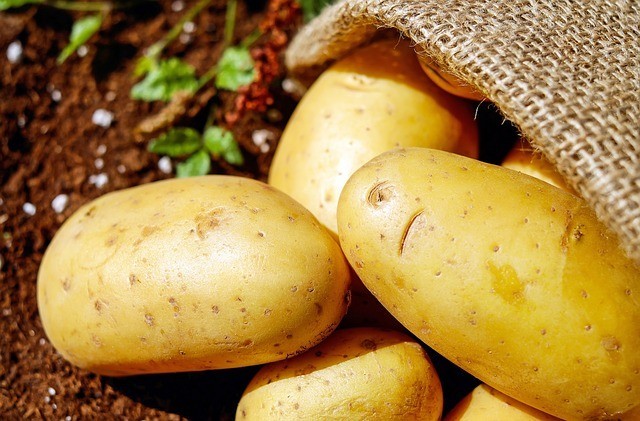True to its name, resistant starch is a type of starch that resists digestion, which means it remains intact as it passes through the small intestine. It has been shown to increase satiety, improve immunity, and reduce inflammation. This soluble fiber is a therapeutic tool in diabetes prevention as it regulates blood sugar, improves insulin sensitivity, and promotes weight loss. Learn how to improve digestion with resistant starch.

Resistant starch is found in a variety of foods, and contains fewer calories per gram than typical starches. Indigestion is so common today that many people are routinely put on medications to mask their symptoms. Natural alternatives are always safer
Table of Contents
Benefits Of Resistant Starch
Because resistant starch (RS) resists digestion, it doesn’t affect blood-sugar and insulin levels. It’s almost like passing go and collecting $200.00. What if you could have your potatoes, and eat them too? Well you can – RS isn’t digested or absorbed in the small intestine so glucose does not enter the bloodstream.
The fiber in RS is processed by bacterial fermentation in the colon. This is where the magic happens, as beneficial fatty acids are produced. One such fatty acid is called butyrate, which is an important energy source for cells in the colon.
Butyrate is anti-inflammatory, reduces oxidative stress, and decreases damage caused by free radicals. It prevents or alleviate intestinal permeability, or leaky gut, by promoting a healthy gut barrier. Leaky gut is linked to autoimmunity, inflammation, allergies, and weight gain. Butyrate is even protective against colon cancer. You can see why increasing levels of butyrate can be so beneficial.
[Read More: 10 Strategies You Can Do TODAY To Prevent Cancer]
- Optimizes gut flora
- Balances blood sugar
- Improves insulin sensitivity
- Reduces appetite
- Improves metabolism
- Increases satiety
- Reduces inflammation
- Improves immunity
- Promotes weight loss
- Increases nutrient absorption
- Binds toxins
- Increases circulation to the colon
- Improves lipid levels
This post contains affiliate links, which means I make a small commission when you purchase from one of my links.
Resistant Starch Is A Prebiotic
RS’s therapeutic effects are due to its effects on gut bacteria. The beneficial bacteria in the large intestine are important for optimal digestion, absorption of nutrients, and hormonal balance. They produce vitamins, excrete toxins, and crowd out harmful bacteria keeping infections at bay, and lowering disease risk. Keeping your microbiome balanced is crucial for overall health and immunity.
Think of RS kind of like a fertilizer for your gut flora. Prebiotics, like resistant starch, are undigested fibers that gut bacteria digest and ferment to create butyrate, and other beneficial compounds so crucial to health.
Imbalances in gut flora have been linked to many conditions, including, diabetes, autoimmunity, inflammatory bowel diseases, depression, and cancer. Feed your gut bacteria with resistant starch to improve the ratio of good and harmful bacteria. Not only does it decrease the colonies of bad bacteria, it makes the good guys even better!
How To Improve Digestion With Resistant Starch
You can find resistant starch in a variety of foods. Many foods naturally contain RS. Other foods have high levels of it by cooking and cooling. Use RS as a trick to eat fewer calories, decrease inflammation, and improve intestinal health.
1. Whole grains – uncooked oats are a fabulous source of RS
2. Beans, lentils, and legumes
3. Cooked and cooled foods like rice, and potatoes
4. Unripened bananas and plantains
5. Pumpernickel and rye bread
6. Onions, garlic, and leeks
7. Chicory root and Jerusalem artichokes
Four Types of Resistant Starch
There are four types of resistant starch:
RS 1 – The type of RS is protected by a hard coating allowing it to easily pass through the small intestine without being absorbed. Grains, beans, lentils, and peas are foods containing this type of starch.
RS 2 – Because of its tightly-packed structure, RS 2 starch resists the action of digestive enzymes remaining intact. Raw potatoes, green bananas, and plantains are examples of foods found in this category.
RS 3 – Retrograde starch is formed when foods like rice and potatoes are cooked and cooled.
RS 4 – A synthetic form of RS, its chemical structure is modified to resist digestion. Hi-maize is an example of RS 4 resistant starch.
Aim for 20-30 grams of RS daily. Uncomfortable symptoms can develop if you jump in too fast so raise levels of resistant starch gradually.
Cooking Affects Starch Content
Cooking greatly affects the starch content of foods, especially foods that are cooked at high temperatures, and for long periods of time. Resistant starch is created when food that has been cooked is cooled. Heat changes the properties of the starch. When cooled, this starch becomes resistant to digestion via a process called retrogradation.
Of particular interest – the more times a food is cooked, cooled, and reheated, the higher the levels of RS. When you reheat foods high in resistant starch, keep the temperature below 130 degrees to maintain the benefits. High temperatures will allow the RS to convert back into a form of starch that is digestible.
We want starch that is indigestible so that it can pass through the digestive tract undigested. The good bacteria in the colon can then convert it into health-promoting small chain fatty acids. American diets are low in resistant starch so making an effort to include more of it in your diet is something worth doing.
My Favorite Way To Eat Resistant Starch
Plantains are a great source of RS. I buy them at Asian markets, and fry them in coconut oil for a crispy treat. They are so filling. Flavor them with your favorite spices, and you’ll be hooked. You can also cook with plantain flour or green banana flour to increase your intake of RS.
An easy way to consume more RS is to cook and cool potatoes and rice. I, typically, have a bowl of red potatoes in my fridge that are convenient when I’m on the run. Sprinkle some sea salt on them for a tasty snack.
Another really simple way to get more RS into your diet is to eat potato starch. Don’t confuse this with potato flour. Studies show that just 2-4 tablespoons a day of potato starch improves insulin sensitivity and promotes weight loss. Potato starch is a great source of RS. It mixes easily into liquid, and one tablespoon contains 8 grams of resistant starch. Toss it in your morning smoothies to increase your RS intake.
Here’s a prebiotic resistant starch blend that’s handy to mix into liquid.
Key Points
Resistant starch is remarkable, and can be a powerful tool to improve your health. Make a mental note of foods containing RS, and make it a point to include these foods in your diet. It’s not difficult, and just one cup of resistant starch will do the trick. Your body will thank you!
What is your favorite way to eat resistant starch? Let me know in the comments:)
Disclaimer: This article is strictly for informational purposes only and is not intended to be medical advice.




This is my first time I’ve read about resistant starch. I haven’t heard about it until now. Thanks to your blog, I got informed on how to improve digestion with resistant starch, and I’m glad to hear that it’s effective at controlling diabetes, good for the immune system and for reducing inflammation.
Diabetes runs in our family so this is a good share. I have bookmarked it and will share it with my family. And I’ll look for plantains at the Asian store also so I can try making them myself with some of my favorite spices.
Hi Gillian,
Resistant starch is a great way to improve digestion if that’s an issue for you. It’s good for balancing blood sugar as well so if diabetes runs in your family, it would be helpful to eat foods that contain resistant starch.
Plantains are one of my favorite foods. They’re delicious cooked in coconut oil and you can use your favorite spices to make them even better. I use nutmeg on mine. And they’re so filling.
Thanks so much for reading and sharing my article!